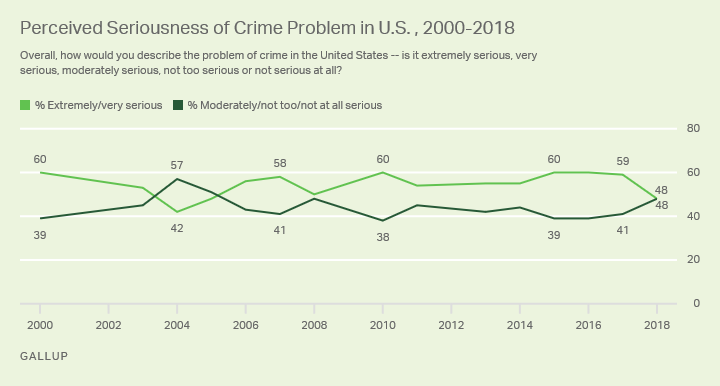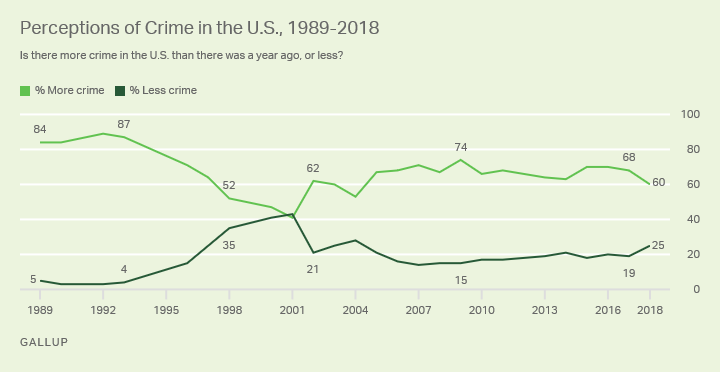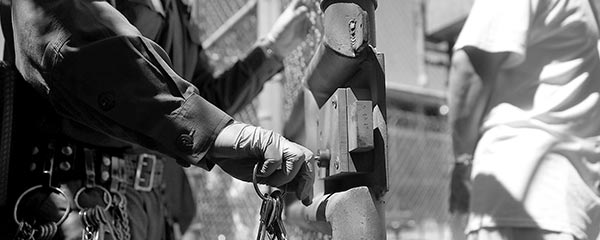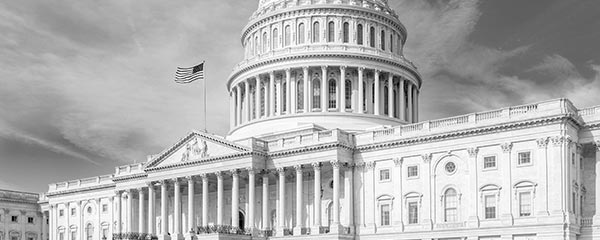Story Highlights
- Percent saying problem is very or extremely serious drops to 12-year low
- Percent saying crime is worsening nationwide at 60%, lowest since 2004
- More say crime is decreasing where they live than say it is increasing
WASHINGTON, D.C. -- Just under half (48%) of Americans believe the problem of crime in the United States is very or extremely serious -- an 11-percentage-point drop from last year's 59% and the first time the number has been below 50% since 2005.

Gallup asked Americans in 2000, and in every year since 2003, whether "the problem of crime in the United States is extremely serious, very serious, moderately serious, not too serious or not serious at all." In all but two years (2004 and 2005), at least 50% said the problem was either "very" or "extremely" serious. It has reached 60% four times -- 2000, 2010, 2015 and 2016.
The question is included in Gallup's annual crime poll, which this year produced strong indicators that Americans' views about crime are more positive than they have been in more than a decade.
- Though a solid majority of Americans (60%) say there is more crime in the U.S. than a year ago, it is an eight-point drop from last year and the lowest percentage to say crime is on the rise since 2004. Twenty-five percent say there is less crime.
- A slight change in the views of Americans about crime in their local area has resulted, for the first time since 2001, in a higher percentage saying crime is decreasing (42%) than increasing (39%). Last year 38% said it was decreasing, up from 33% in 2016.
- Nine percent say crime is a very serious or extremely serious problem in the area where they live -- a small drop from last year's 12%, but the first time it has dipped into single digits since 2004.
National Crime Rate: Public's Perception Clashes With Government Statistics
Government statistics have shown a general decline in crime rates nationally since the 1990s, but Americans have been loath to accept the concept that crime is decreasing.

The FBI's annual reports show a drop in the national violent crime rate in 15 of the 20 years from 1998-2017, with the overall rate falling from 568 crimes per 100,000 persons in 1998 to 383 crimes per 100,000 last year. Over the same time span, Gallup asked Americans in every year but one (1999) if crime was increasing or decreasing nationally, and in all but two years (2000 and 2001) a majority said it was increasing. Only once, in 2001, did a higher percentage say crime was decreasing (43%) rather than increasing (41%).
During that 20-year period, negativity about crime nationally peaked in 2009 with 74% saying there was more crime than in the previous year -- at a time when the FBI's violent crime rate was dropping for the fourth year in a row. In earlier Gallup polls, the percentage who thought crime was on the rise was above 80% in five straight polls from 1989 through 1993.
Americans Growing More Positive About Crime Where They Live
Gallup has also measured whether Americans think crime locally ("in your area") is increasing or declining -- first asking the question in 1972. The 42% who now say their area has less crime than in the previous year is one of the lowest in the 30 times the question has been asked. The only three times the percentage saying "less crime" has been higher -- in 1998 (48%), 2000 (46%) and 2001 (52%) -- are also the only times other than this year that Americans were more likely to say it has decreased than to say it has increased.

In the last two years, there has been a significant change in views on the question after a 12-year stretch when Americans were far more likely to think crime was increasing in their area than to think it was decreasing. From 2005 through 2016, an average of 47% said there was more crime than in the previous year and 31% said there was less. (An average of 18% volunteered the response that crime in their area was about the same.)
Bottom Line
Though majorities of Americans have said since the turn of the century that crime has been increasing and is a very or extremely serious problem, they have shown less concern about it than they did in the 1990s. In that decade, crime often topped the list of what Americans saw as the nation's most important problem; now it is seldom mentioned by more than 3% of those polled. Throughout the 1990s, it ranked as one of the issues that mattered most to voters. In recent national elections it has not been prominent enough as an issue to be measured in election polls.
Now, in addition to those changes, there are signs that the American public is moving toward a more positive perception of the crime situation in the nation -- one that is more in line with what government crime rate measurements tell us has been occurring. While sizable numbers of Americans still think the problem is very serious and increasing, it is encouraging to see that the gap between Americans' perceptions and government-issued crime rates is closing, not because the crime rates are increasing, but rather because the public's views are growing less negative.
View complete question responses and trends.
Learn more about how the Gallup Poll Social Series works.
Editor's Note: The text of this article was updated in several places on November 13, 2019, to reflect the correct 2018 percentages of Americans who believe the problem of crime in the United States is very/extremely serious and moderately/not too serious/not serious at all.




